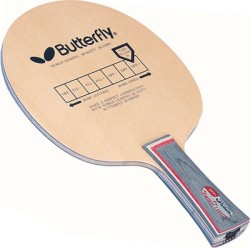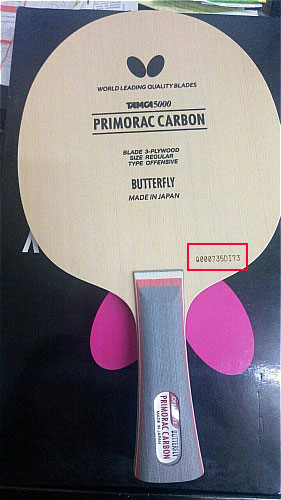There are many factors to consider when choosing a table tennis blade. This information will help direct you to a suitable blade.
The style of a blade’s handle is a player’s individual choice, but most importantly, it must feel comfortable to play with. The main styles should be tried before purchase for beginners to assist in developing a sound playing technique. The three main types of handle shape are: Straight, Anatomic, Flared.
Table of Contents
TogglePly of the Blade
The weight of blades ranges between 60 grams and 120 grams, but most weigh around 85 grams. The weight of blades is getting lighter and lighter with the development and implementation of carbon and titanium technology. A table tennis blade under current rules must be at least 85% wood. The rest of the blade could be made from carbon, glass fiber, kevlar, titanium, and other such materials.
You often see on many product descriptions and statistical tables the term ‘Ply.’ It simply refers to the number of layers of wood and artificial fibers used throughout the blade’s construction.
Ball dwell time refers to the amount of time the ball remains on the blade at the point of contact. It certainly has an impact on control during game-play. If the ball has more extended contact with the blade, it allows increased ability to achieve complete and accurate strokes.
Ball contact can be hard or soft, depending on the type of wood/material used. Softer woods such as Limba and Abachi give a longer ball contact time, whereas harder woods such as Walnut and Mahogany will give shorter ball contact time.
It is essential to play the ball on the most effective part of the blade, the outer area, to achieve maximum spin. To achieve the maximum spin possible, the Ply of the blade should be medium to soft. It is more difficult to spin the ball with a hard Ply.
This figure can vary in scale depending on the manufacturer from 1-10, 1-100. It is used to judge the speed and responsiveness of a particular blade. It helps to identify the tempo, elasticity, and rigidity of the blade.
The concept is that the lower speed factors utilize and enhance control while the higher factors indicate ‘less contact time’ with the ball to exploit and generate more speed, with reduced control. It is essential to analyze the impact of speed upon the control and spin of the blade.
A Simple Summary of Blade Category
I am going to summarize different category blades into simple layman terms for beginners to understand. Even though players are still making use of some older equipment and don’t necessarily agree with the grouping here, it’s a start.

1. Defensive Blades
These types of blades are generally used by defensive, chopping style players.
Speed: Control/Slow (For chopping and control)
Weight: 88-105 grams (generally, it varies depending on the player)
- All Around Blades
These blades are suitable for Offensive and all-round/Offensive players who play with a topspin drive attack.
Speed: All-Around (For the blend of control & power)
Weight: 81-84 grams (lighter for ease of attack)
- Offensive Blades
Primarily used by Offensive players who play from varying distances and want power plus control (compared with extremely offensive players who usually used Power blades).
Speed: Fast/Very Fast (For the blend of control & power)
Weight: 76-89 grams (Balances power & control with good sweet-spot)
- Power Blades (Wood)
These blades are suitable for aggressive players who attack from the middle or far distance.
Speed: Very Fast (Produces high ball speed)
Weight: > 90+ grams (Provides larger sweet-spot & added stability)
- Power Blades (Composite Material – Graphite, Carbon Arylate, etc.)
They are mainly used for aggressive players who attack from the middle or far distance.
Speed: Very Fast (Normally for offensive play. Ball is a very high speed)
Weight: 75-90 grams (Provides a very large sweet-spot without a lot of added weight)
- Quick Attack Blades
These blades are best suited for players who are Offensive and All-Around. They can carry out the quick hit over the table tennis table on topspin shots.
Speed: All-round ( that is not so fast or slow, the medium will be the right word).
Weight: 72-74 grams (Allows for quick over the table hand speed).
I have friends who use outdated equipment, the oldest from circa 1960s bat but kept it as a collection.
The groupings are just a general guide, there may be some overlapping between blades, but I would say it is a start to beginners understanding the blades. Compared with the first time when I took up table tennis, I knew nothing about blades, rubbers, techniques, etc.
Ever Notice Serial Number on Blade?
Suppose this has never come to your attention. In that case, you may notice that Butterfly blades that were bought from Japan will have the serial number printed on the blade surface (this apply to blade not more than 3 years old) while the same Butterfly blades bought from Europe do not have the serial number.
Many people wonder why the differences. Are there any quality differences between the blade that bought from Japan and Europe? Or it depends on where the blade is manufactured, like Made in China vs. Made in Japan?

I also don’t know the difference and have no idea about the quality, but there is a difference in playing characteristics. A Korbel from Europe feels harder and is lighter than those from Japan. As a Butterfly fan, I prefer the old stock, the 1st generation of Butterfly blade.
May be Used for After Sales Service
My guesswork, I think Japan’s equipment needs some approval from the JTTAA, which is unlike other countries. That may be why the blade that is manufactured in Japan has some additional information on the blade. As you may know, the serial number is for after-sales service. That is one way to keep track of where the blades are sold.
The blades from the Asian market may differ from the European market, as some online table tennis stores have clarified. More than the characteristics of the blades, the manufacturers look at cost-effectiveness. They may not like making the blades manufactured in China exported to Europe to sell there, while some companies in Europe can make the same blade cheaper.
I would love to add that serial numbers have only started being used recently by Butterfly, perhaps to prevent copies from coming out of China. The first generation of Butterfly has only the metal logo.
The oldest has the word Butterfly in nice calligraphy and no writing on the playing surface. More recently, they have a serial number and silver logo and serial numbers.
What About Even Older Blades from Butterfly?
If we talk about Butterfly before the late 70s, they didn’t even have the metal logo, I think. It should say something like Tamasu co. That’s my guess from seeing a few of the older ones.
I have one Butterfly from the 60s(or was it 70s) that only has a sticker with the word “Tamasu Co.” This blade is kept in my house storeroom. If you dwell in Butterfly table tennis’s history, you will notice the first generation of Butterfly blade, which has only the metal logo. Then followed by the “Butterfly” block letter, and then the serial numbers come next. You can do your due diligence if you are interested in finding out more.
Related post:
2 Major Changes in Modern Table Tennis the Last Decade

Warren Davies
Hi, I’m Warren Davies, a table tennis addict who loves sharing tips, reviews, and everything you need to level up your game. I’ve spent years playing, testing gear, and geeking out over the sport, and I’m here to make things simple and fun for players of all levels. When I’m not writing, you’ll probably find me perfecting my forehand or trying out the latest paddle.








